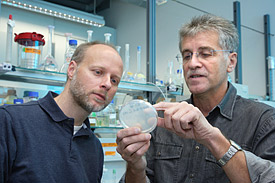Scientists from Germany have discovered a new enzyme responsible for a revolution in the production of plastics

In the future, polymethyl methacrylate (PMMA) - or as it is more famously called acrylic glass - could be produced from natural raw materials such as sugars, potassium or fatty acids. Compared to previous chemical production processes, biotechnological processes are much more environmentally friendly.
Acrylic glass (Acrylic glass) or by its famous name Plexiglas (Plexiglas) is a synthetic polymer plastic of the monomer called methyl methacrylate. The acrylic glass has many other names such as polymethyl methacrylate, plexiglass, acrylic, acrylplast and also acrylic. The material was developed in 1928 in several different laboratories and entered the sales circuit in 1933 by the Rohm and Hass company. It is mainly used as a durable and lightweight replacement for glass - for example, in goggles or vehicle headlights. It has many uses, including - as a component in prostheses, paints and adhesives. The resulting plastic is indeed fragile, but it is very resistant to ultraviolet radiation and is therefore immune to the elements. Today, in order to produce one kilogram of acrylic glass, two kilograms of oil have to be distilled. Experts estimate that the demand for this material will grow even more in the future for uses in photovoltaic cells.
Scientists from the University of Duisburg-Essen and the Helmholtz Center for Environmental Research (UFZ) in Germany discovered an enzyme that could be used for the biotechnological production of a substance leading to the creation of the substance methyl methacrylate. Dr. Thore Rohwerder, who is responsible for the research, was one of three candidates for a prestigious research award from a European foundation for this discovery.
The innovative enzyme discovered by the researcher and his colleagues is called "2-hydroxyisobutyryl-CoA mutase" (2-hydroxyisobutyryl-CoA mutase) and enables the conversion of an unbranched chain of four carbons to its branched form. Compounds of this type are precursors to monomers. The revolutionary aspect lies in the fact that this enzyme, through its assimilation into suitable microorganisms, is also able to convert sugars and other natural substances into the desired products. Until now, the only way to create this precursor - "2-hydroxyisobutyrate" (2-HIBA) was through a completely chemical process based on petrochemical raw materials.
The global chemical industry is looking for suitable biological processes, so that in the future it will also be possible to use renewable raw materials for the preparation of the desired monomer. The mutase presented above provides the solution: an enzyme that transfers a functional group from one position to another in the same compound. The researchers discovered the new enzyme in a new strain of bacteria, a strain that was discovered during their search for a bacterium that could break down the polluting substance methyl tertiary butyl ether (MTBE).
The industrial importance of this discovery lies in the fact that the experts predict that up to ten percent of the current consumption of this substance could be produced by biotechnological means. The world market for this material is estimated at three million tons or four million euros. It is estimated that it will take a period of four years to establish a biological system that will eventually function as a technological process (experimental facility). It is likely that within ten years a technological process with a financial turnover of 150-400 million euros will be possible.

2 תגובות
There is an error here:
"The world market for this material is estimated at three million tons or four million euros"
I guess it means four billion euros...
"To produce one kg of acrylic glass, two kg of oil must be distilled"?
- It is possible that there is a mistake here and the intention is to refine a larger amount of oil - maybe even two tons??
Because if two kilograms of oil can be used to produce one kilogram of acrylic glass - who needs replacements or improvements, and the price should also be on the floor!!